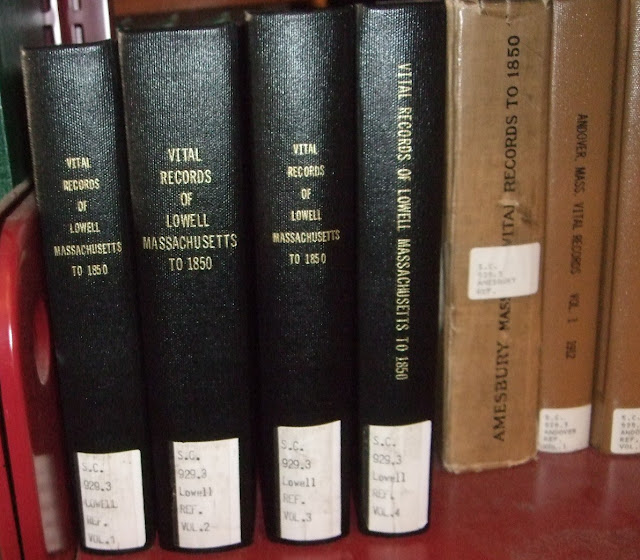Many genealogists doing early Massachusetts research will probably use the Vital Records, either on microfilm or in book form. The books are often referred to as the "Tan Books." However, as indicated by the photos below, that term may not make much sense in the future. As I've been revisiting the majority of the libraries for my Library series, I've noticed a change. The "Tan Books" are changing color. The orange books are from the Chelmsford, MA library, and the black ones from Lowell, MA. In addition, I've seen blue and green bound books. I'm not sure if the library is deciding on the colors when they are rebound, maybe I'll ask. All I want you to be aware of is the fact that they are not all tan.
From Archive Publishing, their description of the Massachusetts Vital Records to 1850 is below.
PRINTED VITAL RECORDS FOR 2/3 OF STATE
Are you searching for names in Massachusetts? If so, maybe you've already looked through the tan books of the old printed series of vital records to 1850. This series, published nearly a hundred years ago for 210 of the 350 or so Massachusetts towns and cities, lists births, marriages, and deaths for the earliest settlers, and continues through 1849.
SOURCE OF DATA
Most of the data come from original records safeguarded in town halls, sometimes supplemented with facts from church, cemetery, court, or family bibles. Because the information comes from such a diverse group of sources, many now missing; these books, compiled years ago as a secondary source, sometimes now serve as the only link to primary-source documents.
VALUE OF PRINTED RECORDS
Not only do these volumes contain valuable data, but they are easy to use; being printed, with names arranged alphabetically, cross-referenced to alternate spellings, and placed in categories of births, marriages, and deaths. Further, though not entirely error-free, these records are remarkably accurate.





